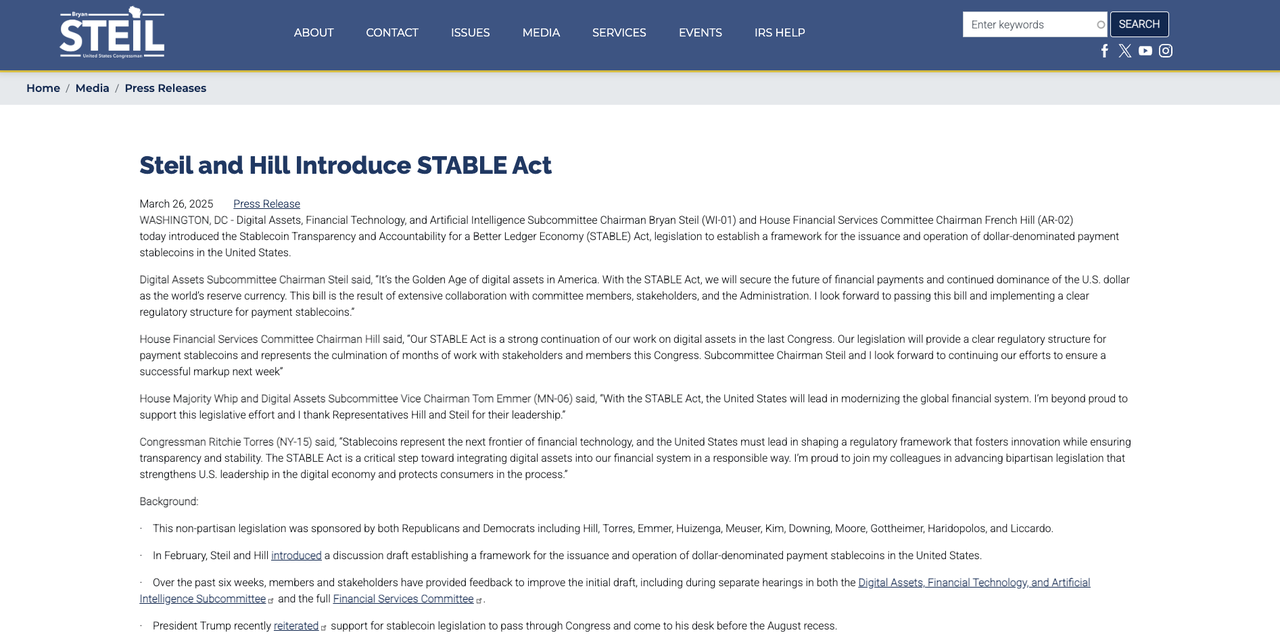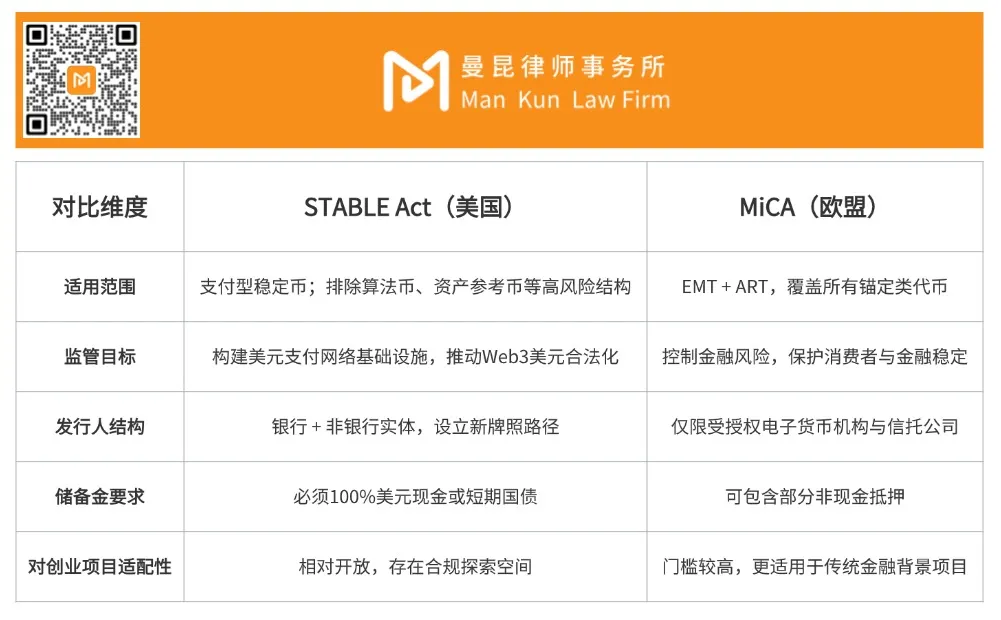Interpreting the US stablecoin bill STABLE Act, the on-chain US dollar "hegemony"?

Reprinted from panewslab
04/10/2025·1MAuthor of this article: Iris, Lawyer Mankun
Over the past few decades, the US dollar's global dominance has relied on the evolutionary mechanism of "Bretton Woods System-Petro Dollar-U.S. Treasury + Swift System". However, as we enter the Web3 era, decentralized financial technology is gradually shaking the traditional clearing and payment paths, and stablecoins anchored to the US dollar are quietly becoming a brand new tool for "dollar going overseas".
Against this background, the significance of stablecoins has long surpassed the compliance of a single crypto asset. It may be the digital carrier for the continuation of the "dollar hegemony" in the Web3 era.

On March 26, 2025, the US Congress formally proposed the Stablecoin Transparency and Accountability for a Better Ledger Economy Act, systematically establishing the issuance threshold, regulatory structure and circulation boundaries of the US dollar stablecoin for the first time. As of now, the bill has been reviewed by the House of Representatives Financial Services Committee on April 2 and can only become law after it is voted by the House of Representatives and the Senate. This is not only a response to the long-term regulatory vacuum of the stablecoin market, but perhaps it is also a key step in trying to build the next generation of US dollar payment network "institutional infrastructure".
So, what exactly does this new bill solve? Does the difference with MiCA reflect the United States’ “institutional strategy”? Are you paving the way for the hegemony of the Web3 dollar?
Lawyer Mankun will share these issues in this article.
What kind of US dollar stablecoin should STABLE Act establish?
According to the documents, the stablecoin bill launched this time attempts to establish an exclusive compliance framework that is clearly applicable to "Payment Stablecoins". We refine its five core points:
1. Clarify the regulatory targets and focus on "payment-type
stablecoins"
The first step in the STABLE Act is to clarify the core object of regulation: USD-anchored stablecoins issued to the public and can be used for payment and settlement. In other words, what is really included in the regulatory framework are those crypto assets that are used as "dollar alternatives" on the chain, not all tokens claiming to be pegged to the dollar.
To avoid the spread of risks, the bill also explicitly excludes some high-risk or structurally unstable token models. For example, algorithmic stablecoins, partially collateralized stablecoins, or "pseudo stablecoins" with speculative attributes and complex circulation mechanisms are not within the scope of application of this bill. Only stablecoins that achieve full support for 1:1 US dollar assets, have a transparent reserve structure, and are circulated in daily trading for the public can be considered a "payment-type stablecoin" and must be accepted under this bill.
From this perspective, what the STABLE Act really focuses on is not the "technical carrier" of stablecoins, but whether it is building a "dollar payment network on the chain." What it needs to standardize is the issuance method and operation basis of "digital dollars", rather than all tokens with the word USD.
2. Establish a “redemption right” mechanism, with a 1:1 dollar anchor
In addition to regulatory entry thresholds and issuer qualification requirements, the STABLE Act particularly emphasizes the "redemption rights" arrangement of stablecoins for holders, that is, the public has the right to redeem the stablecoins in their hands as US dollar fiat currency at a ratio of 1:1, and the issuer must fulfill this obligation at any time. This institutional arrangement is essentially to ensure that stablecoins do not become "pseudo-anchored assets" or "system tokens for internal circulation".
At the same time, in order to prevent liquidity crises or runs, the bill also sets clear asset reserves and liquidity management requirements. Issuers must hold 1:1 ratio of high-quality, ready-to-realize US dollar assets (such as Treasury bonds, cash, central bank deposits, etc.) and accept continuous review by the Federal Reserve. This means that stablecoin issuers cannot "use users' money to invest in high-risk assets" or use algorithms or other derivative structures to achieve "anchoring".
Compared with some stablecoin models with "partial reserves" and "fuzzy disclosure" in the early market, the STABLE Act wrote "1:1 redeemable" into federal legislation, which represents the United States' higher requirements for the underlying credit mechanism of "digital dollar alternatives".
This not only responds to the public's concerns about the "deaning" and "explosion" of stablecoins, but also intends to create an anchor system of institutional guarantees + legal trust for the US dollar stablecoins to support its long-term use in the global clearing network.
3. Strengthen the supervision of funds and reserves to avoid "trust
idleness"
On the basis of "stable coins must be redeemable 1:1", the STABLE Act further makes clear provisions on the types, management methods and audit mechanisms of reserve assets, with the intention of controlling risks from the source and avoiding the hidden dangers of "surface anchoring and substantial idleness".
Specifically, the bill requires all payment stablecoin issuers:
-
You must hold equal amounts of "High-Quality Liquid Assets", including cash, short-term US Treasury, Federal Reserve Account Deposits, etc., to ensure user redemption requests;
-
Reserved assets shall not be used for lending, investing or diverting them for other purposes to prevent systemic risks caused by "using reserve money to make profits";
-
Regularly accept independent audit and regulatory reporting obligations, including reserve transparency disclosure, exposure reports, asset portfolio descriptions, etc., to ensure that both the public and regulators have an understanding of the asset basis behind the stablecoin;
-
Reserve assets must be isolated and stored in the FDIC insurance bank or other compliant custodian accounts to avoid project parties including them in their own fund pool for mixed use.
The purpose of this institutional arrangement is to ensure that "anchor" is real, auditable and fully fulfilled, rather than "anchoring on the mouth and floating profits on the chain". Judging from historical experience, the stablecoin market has experienced many credit crises caused by false reserves, misappropriation of funds or lack of information disclosure. The STABLE Act is to block these risk ports through the institutional level and strengthen the "institutional endorsement" of the US dollar anchoring.
On this basis, the bill also gives the Federal Reserve, the Treasury Department and designated regulatory agencies a long-term supervision of reserve management, including freezing illegal accounts, suspending issuance rights, and compulsory redemption and other intervention methods, forming a relatively complete closed-loop of stablecoin credit.
4. Establish a "registration system" and include all issuers in
supervision
In the design of regulatory paths, the STABLE Act does not adopt "license classification management", but establishes an access mechanism with a unified registration system. The core point is: all institutions that intend to issue payment stablecoins, whether they are banks or not, must be registered with the Federal Reserve and undergo regulatory review at the federal level.
The bill sets two types of legal issuers: one is the Insured Depository Institutions (Insured Depository Institutions) that can directly apply for issuing payment stablecoins; the other is the Nondepository Trust Institutions, which can also be registered as a stablecoin issuer as long as they meet the prudent requirements set by the Federal Reserve.
The bill also emphasizes that the Fed not only has the right to approve registration, but also can refuse or revoke registration when it considers a systemic risk. In addition, the Federal Reserve has also been granted the power to continue to review the reserve structure, solvency, capital ratio, risk management policies, etc. of all issuers.
This means that in the future, all issuance of US dollar payment stablecoins must be included in the federal regulatory network, and censorship will no longer be allowed to be bypassed by means of "state registration only" or "technologically neutral".
Compared with the previous looser multi-path discussion plans (such as the GENIUS Act allows starting with state supervision), the STABLE Act clearly demonstrates stronger regulatory unity and federal dominance, trying to establish the legal boundaries of US dollar stablecoins with a "national registration regulatory system".
5. Establish a federal-level licensing mechanism to clarify multiple
regulatory paths
The STABLE Act also establishes a federally-level stablecoin issuance licensing system and provides diversified compliance paths for different types of issuers. This institutional arrangement not only continues the "federal-state dual-track" structure of the US financial regulatory system, but also responds to the market's expectations for flexibility in compliance thresholds.
The bill sets three optional paths for issuing "payment stablecoins":
-
First, it has become a federally recognized payment stablecoin issuer (National Payment Stablecoin Issuer), which is directly reviewed and licensed by the US federal banking regulators (such as OCC, FDIC, etc.);
-
Second, as a licensed savings bank or commercial bank, it can enjoy higher trust endorsement, but it must comply with the capital and risk control requirements of traditional banks;
-
Third, operate on a state-level license basis, but must accept federal-level "registration + supervision" and meet unified standards such as reserves, transparency, and anti-money laundering.
The intention behind this institutional design is to encourage stablecoin issuers to "register on the chain" in accordance with the law and include them in the financial regulatory perspective, but do not force banking "one-size-fits-all" so as to achieve controllable risks while protecting innovation.
In addition, the STABLE Act also gives the Federal Reserve (FED) and the Treasury more extensive coordination powers, which can make additional requirements for stablecoin issuance, custody, and transactions based on systemic risk levels or policy needs.
In short, this system has created a multi-level, multi-path, hierarchical and hierarchical regulatory stablecoin compliance network for the United States, which not only improves system resilience, but also provides a unified institutional foundation for stablecoins to go overseas.
Compared with MiCA, the United States has taken a different route
In the global stablecoin regulatory competition, the EU is the earliest and most complete region. The MiCA Act, which was officially implemented in 2023, incorporates all crypto tokens anchored to assets into the regulatory perspective through two types: "EMT" (electronic currency tokens) and "ART" (asset reference tokens), emphasizing macro-prudentials and financial stability, and intends to build a "firewall" in the transformation of digital finance.
But the US "STABLE Act" obviously chose another path: it is not to fully manage all stablecoins, nor to build an all-encompassing regulatory system based on financial risks, but to focus on the core scenario of "payment-based stablecoins" and build the next-generation payment network on the US dollar chain in an institutional way.
The logic behind this "selective legislation" is not complicated - the US dollar does not need to "conquer the world" in the stablecoin world, it only needs to consolidate the most critical scenario: cross-border payments, on-chain transactions, and global US dollar circulation.
This is why, the STABLE Act does not attempt to establish a MiCA-like full-asset regulatory system, but focuses on "on-chain dollars" that supports 1:1 USD, has actual payment functions, and is acceptable to the public for widespread holding and use.

From the perspective of institutional design, the two show a sharp contrast:
-
The scope of regulation is different: MiCA tries to "snatch it all in one place", covering almost all stablecoin models, including extremely risky reference asset products; while the US STABLE Act actively narrows its scope of application, focusing only on assets that are truly used for payment and can represent the "dollar function".
-
Different regulatory goals: the EU emphasizes financial order, system stability and consumer protection, while the United States focuses more on clarifying through laws that can be used as a legal form of "on-chain USD", thereby building a USD payment infrastructure at the institutional level.
-
The issuing entities are different: MiCA requires that stablecoins must be issued by regulated electronic currency institutions or trusted companies, almost locking the entrance into the financial institution system; while the STABLE Act establishes a "new license mechanism" to allow non-bank entities to participate in the issuance of stablecoins in accordance with the law, thus retaining the possibility of Web3 entrepreneurship and innovation.
-
Different reserve mechanisms: the United States requires 100% USD cash or short-term Treasury bonds, strictly excluding any leveraged or non-current assets; the European Union allows a variety of asset forms including bank deposits, bonds, etc., which also reflects the different rigorousness in regulatory thinking.
-
The adaptability to Web3 entrepreneurship is different: MiCA has a high reliance on traditional financial licenses and audit processes, which naturally forms high barriers to crypto startups; while the STABLE Act in the United States has strict requirements, it leaves room for innovation in the system, aiming to encourage the development of the "on-chain dollar" through compliance standards.
In short, what the United States has taken is not a "full management" route, but a institutional path to screen "USD payment of qualified assets" through compliant licenses. This not only reflects the changes in the United States' acceptance of Web3 technology, but also a "digital extension" of its global monetary strategy.
This is why we say that the STABLE Act is not a pure financial regulatory tool, but the beginning of the institutionalization of the digital dollar system.
Summary of Lawyer Mankun
Making the US dollar the benchmark unit for global Web3” may be the real strategic intention behind STABLE Act.
The US government is trying to build a "new generation of digital dollar network" that can be identified by programs, audited and integrated through stablecoins, to fully lay out the underlying protocol for Web3 payments.
It may not be perfect yet, but it is important enough in the moment.
It is worth mentioning that at the international level, the seventh edition of the "Balance of Payments Manual" (BPM7) released by the IMF in 2024 has included stablecoins in the international asset statistics system for the first time, and emphasized its new role in cross-border payments and global financial flows. This not only laid the "global institutional legitimacy" for the sovereignty and compliance of stablecoins, but also provided institutional support and external recognition for the United States to build a stablecoin regulatory system and strengthen the significance of the US dollar anchoring.
It can be said that the global institutionalized acceptance of stablecoins is becoming the prelude to sovereign competition in the era of digital currency.
This is just as Mankun Lawyer observed: Web3's compliance story is ultimately a competition for institutional construction, while US dollar stablecoin is the most practical battlefield in this competition.



 jinse
jinse